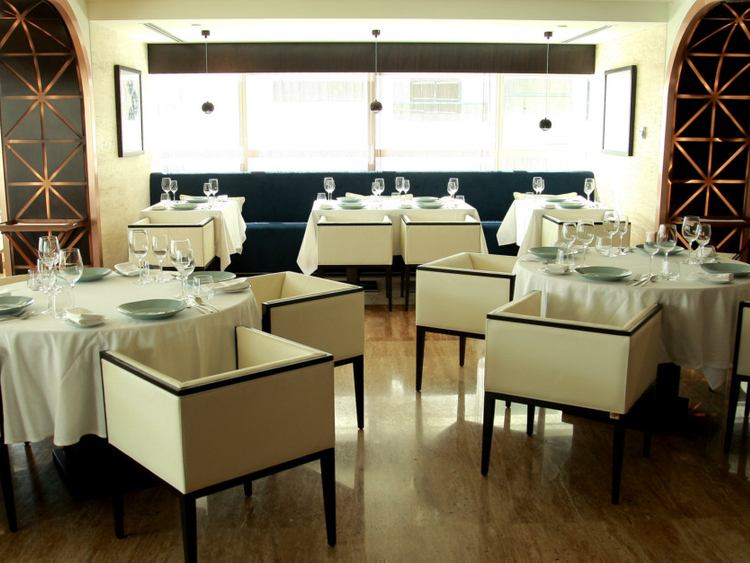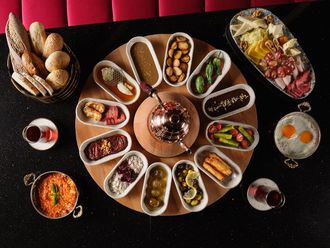
There’s no denying we Indians love a hearty, lavish meal and Tresind at Radisson Royal on Shaikh Zayed Road, Dubai, one of the newest addition to modern Indian cuisine in the city, is here to enhance that experience. One of the few restaurants in the world to incorporate molecular gastronomy into Indian food, Tresind serves up a storm in a tea cup — well, on a plate, at least.
After a repeat order of the deconstructed pani puri (a bubble filled with a concoction of spicy mint and tamarind flavoured water and served with tiny deep-fried flour balls), we embarked on our “exciting, surprising experience” — as Himanshu Saini, the restaurant’s executive chef and creator of the dishes, calls it — with the quintessential Indian appetizer, chaat. The hot and sour savoury dish receives a technological twist with a blast of liquid nitrogen. And it is served with fanfare as sous chef Harangad Singh splashes whites, greens and browns on a large tray before mixing the liquid nitrogen-blasted dhokla (a steamed savoury snack made of gram flour, tempered with mustard seeds and curry leaves), papdi (crispy fried bread), palak pakoda (spinach fritters) with the mint chutney, yoghurt and tamarind gel.
If you were eating blindfolded, the spicy, tangy, flavours will transport you to a street-side stall in India, even though I cannot say I was a big fan of the frozen, brittle dhokla, which is otherwise served soft and spongy, soaked with lemon juice. The tamarind gel, explained Singh, is not really a tamarind chutney but a gel created through molecular gastronomy techniques using tamarind paste and gelatin and the dhokla is blasted to turn its soft texture into a hard brittle.
“Molecular gastronomy breaches the boundaries of the rigid Indian cuisine and as only few restaurants serving Indian cuisine have incorporated it, it’s quite a new concept still,” said 27-year-old Saini, one of fastest-rising names in modern Indian cuisine. “But we’ve used it only in dishes whose taste, flavour and presentation we felt would be enhanced by it.”
The 12-course chef’s tasting menu, including dishes such as mushroom galauti kebab (finely minced mushroom kebab), aam papad braised lamb chops (lamb chops cooked with a sauce made from aam papad, a sweet, gummy mango product, similar to liquorice) and pepper prawn over fried poha (dried flattened rice) will definitely make your taste buds tingle with excitement.
But these are only the starters. Two palate cleansers are offered too, which are just as tasty as the starters or the main course. After the chaat, a mushroom tea, Saini’s signature concoction from an earlier post at Masala Library by Jiggs Kalra in Mumbai, is served, while a khandvi (another savoury Indian snack made with steamed sheets of gram flour and tempered with mustard seeds) flavoured yoghurt sorbet is served before the entree is brought in. I could fill reams talking about the main course dishes, the scrumptious duck meatball with a soft egg yolk centre in Chettinad sauce, and the delicious lobster in creamy, coconutty sauce poured over foam. Never a duck fan, I was a little hesitant to try the duck kofta (meatball) but the spices envelop the gamey flavour of the meat so well that it was hard to resist with the soft appams (hoppers). At the same time the sweet-savoury Malaysian-Indian inspired flavours of the lobster were a perfect accompaniment to the parathas (fried Indian flatbread) and naan (oven-cooked flatbread).
There’s no Indian cuisine without dal makhani (slow-cooked black lentils) and it’s my usual gauge to measure the quality of Indian food. Though it did not disappoint, this time it had to take the back seat.
With the wonderful flavours on my palate I wasn’t too keen to taste the daulat ki chaat, a traditional Indian sweet from Lucknow, meaning ‘wealthy dish’, recreated as a foam of condensed milk served with pulled sugar and 24 carat gold dust; and baked jalebi taco with a stuffing of rabdi pannacotta with cottage cheese churros and saffron. But if you do have a sweet tooth, you will definitely enjoy them.
Tresind, a combination of the French word ‘tres’ meaning ‘very’ and ‘ind’, short for ‘India’ is true to its name. Despite its interesting packaging, every dish screams authentic Indian.
“It’s important that one should maintain the essence of Indian flavours. If you compromise on them the authenticity will be lost and the fusion will make it even more difficult to compare with [classical] Indian dishes,” Saini told tabloid!. “We’ve tried to reinvent the classical dishes by giving them a twist. We worked really hard on the mixology of the ingredients because it’s important if it’s fusion [food] the ingredients on the plate should not contradict each other”.











